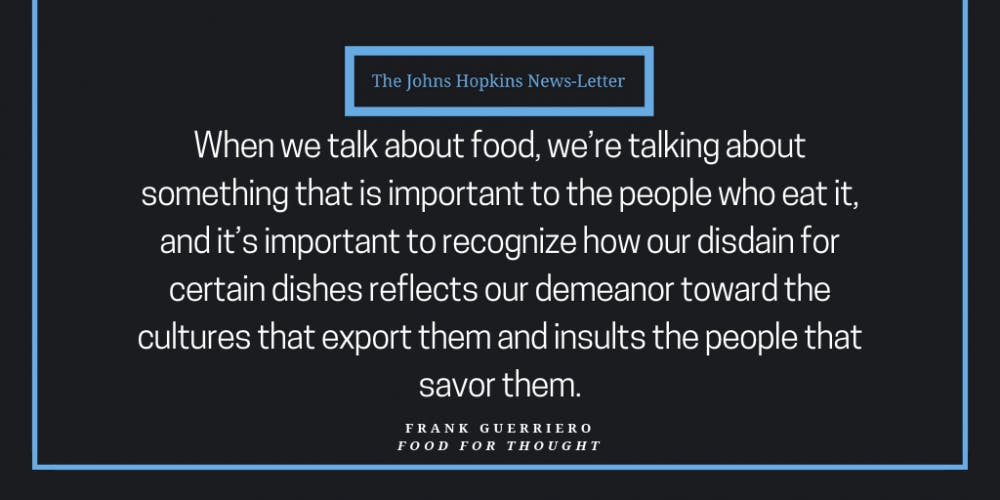
Sitting down at a miraculously vacant table in the Levering Café during that 12:50 to 1:30 lunch rush, I prepared my defense.
“No, it’s totally cooked.”
“You eat canned tuna, don’t you?”
“Taste it, you really can’t tell the difference.”
I love canned chicken breast, and I have my entire life. I mix it with avocado and red onions for a healthy-ish chicken salad sandwich, fold it into the filling for chicken pot pie and sometimes even drop it into a soup when I don’t feel like simmering a raw breast.
It may be excessively salty but it’s totally palatable, and I mean it when I say you usually can’t distinguish between this modern marvel and a freshly poached bird.
Yet every time a roommate has discovered it in the pantry or a friend has learned I’ve tossed it into a shared lunch, I’ve had to defend this staple of my family’s school lunches and weeknight dinners. And in those moments there always appears one particular epithet: gross.
To be fair, my friends may be right. Treating chicken with enough nitrates and salt to preserve it for years and sealing it in a strangely squat metal vessel is a little suspect. But I still can’t understand why this simple product never fails to provoke such visceral disgust, nor why everyone refuses to just give it a shot.
I’m here to proclaim my love for the gross foods in my life. Some of them come from tradition, some from laziness and some from necessity, but all are delicious.
Take, for instance, the notorious sausage-in-a-blender. My aggressively Italian–American family has always consumed a medically inadvisable amount of sausage and peppers, but my mom would often overestimate just how many trays we could tackle at a Sunday afternoon birthday party.
In an effort to purge the fridge of leftovers, she would sometimes chuck the greasy pork–pepper medley into a food processor, then warm it up and serve it with pasta (usually my sworn nemesis, penne). My brother and sister revolted at the smell of fennel seed and the sound of a Cuisinart motor, but it remains a favorite childhood taste memory for me.
In fact, it’s been a passion project of mine to elevate this humble plate to higher esteem, at least within my tiny kitchen. I like to free sweet Italian sausage of its casing before searing it up, then braise it with fresh chiles, bell peppers, tomatoes, and diced fennel to form what amounts to a ragù. Served with a superior pasta shape like rigatoni, it’s a warm reminder of home with an extra dose of self-respect.
This past summer, however, Momma G. reached a new level of grody–gourmet. Always a crusader against food waste (Dan Barber stole her look), she was incensed to notice that half a bag of Cool Ranch Doritos had gone stale after my sister’s graduation party.
She — and this is a true story about a 46–year old woman who has been cooking for her family since she was nine, owns at least three dozen cookbooks and is lauded within a large Sicilian clan for her kitchen game — laid out some chicken breasts in a pyrex pan, opened a can of Rotel tomatoes over the top and sprinkled the dish with crushed Doritos.
The result, a deconstructed casserole of sorts (if we’re being generous), was a stoner’s fever dream and a food stylist’s nightmare, but, most importantly, it was delicious. And yeah, sure, it was gross.
Of course, I should clarify that I don’t see a revulsion toward these few foods as an attack against me or my culture. Those dishes I hold most dear and that have the most cultural salience to me — like stuffed artichokes, pasta with bread crumbs and anisette cookies — have seldom been the object of others’ disgust.
But “gross” can certainly carry a much more sinister significance. When we talk about food, we’re talking about something that is important to the people who eat it, and it’s important to recognize how our disdain for certain dishes reflects our demeanor toward the cultures that export them and insults the people that savor them.
I saw plenty of this particular brand of culinary racism working in both Taiwanese and Indian restaurants. Even a dish like eggplant bharta —little more than some smoky tandoori-roasted vegetables stewed with peas — would sometimes be met with a grimace when it arrived at the table.
It’s hard to say if this came from racism toward South Asians in general or an exclusively-culinary aversion to new things. Regardless, it always reflected poorly on the recoiling guest, and if I was insulted as a server with no connection to the origin of those dishes, I can only imagine how the chefs and owners felt.
So my message here is threefold: First, take pride in the “gross” foods in your life, whatever they are. Savor them, defend them and don’t let anyone shame you for loving them.
Second, think twice before you use this term to describe something new to you. Remember how intimately significant food can be and how expressing such a distaste insults the people who adore these dishes.
And finally, give it a try. Odds are, you’re wrong, and you’ll find a new favorite in previously uncharted territory.





